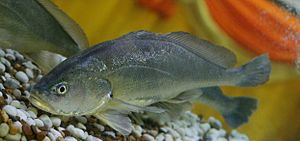Boesemania microlepis
| Boesemania microlepis | ||||||||||||
|---|---|---|---|---|---|---|---|---|---|---|---|---|

Boesemania microlepis , young specimen, about four inches long |
||||||||||||
| Systematics | ||||||||||||
|
||||||||||||
| Scientific name of the genus | ||||||||||||
| Boesemania | ||||||||||||
| Trewavas , 1977 | ||||||||||||
| Scientific name of the species | ||||||||||||
| Boesemania microlepis | ||||||||||||
| ( Bleeker , 1858) | ||||||||||||
Boesemania microlepis ( English Boeseman croaker ) is a Southeast Asian freshwater fish from the Umberfish family(Sciaenidae) and the only species of the genus Boesemania, which is monotypical . It occurs in Southeast Asia in the Mekong in Thailand , Laos , Vietnam and Cambodia as well as on Sumatra . The generic name honors the Dutch ichthyologist Marinus Boeseman , the specific epithet indicates the small body scales.
features
Boesemania microlepis reaches an average of about 50 centimeters and a maximum of about one meter in length and a weight of up to 18 kilograms. The body is gray-brown, becoming lighter in color towards the belly and has weak dark lines on the back. The fins are yellowish, the dorsal and caudal fins are slightly darkly mottled. The mouth is terminal, large and the corners of the mouth run down slightly. Both jaws have two rows of teeth, the outer ones being larger in the upper jaw and the inner ones being larger in the lower jaw. The gill trap has 7 to 12 thorns on the first gill arch. The dorsal fin has ten, less often nine, hard rays in front of the indentation and one hard and 27 to 34 soft rays behind it. The anal fin has two hard rays, the first of which is small and the second very large and powerful. This is followed by seven soft rays. The pointed caudal fin sits on a long caudal stalk. The swim bladder used to generate the noise has a complex structure with a carrot-shaped main part, two forward-facing and five or six rear-facing appendages.
Way of life
Boesemania microlepis colonizes large rivers up to the brackish estuaries. It is mostly close to the ground. There is no evidence of major hikes. Crustaceans, insects and small fish serve as food. In the dry season, the animals in deep water areas of the Mekong make loud croaking noises that could be related to the mating. Eggs are laid from February to May.
use
The species is an important and valued food fish that is freshly marketed. Due to the heavy fishing, the stocks have decreased to around 10 to 20% of their original size. The species is therefore protected by law in Laos and may not be caught during the spawning season and not traded all year round. In addition, the spawning grounds are designated as protected areas.
swell
- K. Sasaki: Sciaenidae . Croakers (drums). In: Kent E. Carpenter, Volker H. Niem (Eds.): The living marine resources of the Western Central Pacific . tape 5 , Bony fishes part 3 (Menidae to Pomacentridae). Food and agricultural organization of the United Nations, 2001, ISSN 1020-6868 , p. 3117-3174 (English, 203.158.191.28 [PDF]).
Individual evidence
- ↑ a b Boesemania microlepis on Fishbase.org (English)
- ↑ D. Dudgeon: River management for conservation of freshwater biodiversity in monsoonal Asia . In: Ecology and Society . tape 10 , no. 2 , 2005, p. 15 (English, indiana.edu [PDF]).
Web link
- Boesemania microlepis inthe IUCN Red List of Threatened Species 2013.2. Posted by: Baird, I., 2011. Retrieved February 7, 2014.